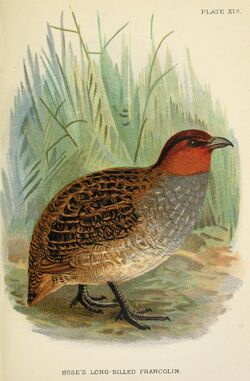Biology:Hose's partridge
| Hose's partridge | |
|---|---|

| |
| Scientific classification | |
| Domain: | Eukaryota |
| Kingdom: | Animalia |
| Phylum: | Chordata |
| Class: | Aves |
| Order: | Galliformes |
| Family: | Phasianidae |
| Genus: | Rhizothera |
| Species: | R. dulitensis
|
| Binomial name | |
| Rhizothera dulitensis Ogilvie-Grant, 1895
| |
| Synonyms | |
|
Rhizothera longirostris dulitensis | |
Hose's partridge (Rhizothera dulitensis), also known as Dulit partridge, has been considered a distinctive subspecies of the long-billed partridge, a bird in the Phasianidae, or pheasant, family. It is endemic to Borneo,[2] where it appears to be separated altitudinally from the nominate subspecies, and is often considered now to be a full species, Rhizothera dulitensis. It is little-known, rare, and has not been recorded since 1937.[3]
Description
The partridge is 30 cm in length. Like the long-billed partridge, it is mainly rufous-buff in colour, with a lavender-grey breast-band, a long, black, curved bill and yellow legs. It differs from the long-billed partridge in that the grey breast band is twice as wide, and the underparts are whitish-buff rather than bright orange-buff.[4]
Distribution and habitat
The partridge is confined to lower montane forest on the mountains of Borneo. It was first recorded from Mount Dulit and later found on Mount Murud and Mount Batu Song, all in northern Sarawak.[4] Two specimens were collected by Everett on Mount Kinabalu in Sabah in 1895, but it has not been recorded from that state since.[3]
Status and conservation
Orenstein et al. (2010) suggest that the partridge may be seriously threatened by habitat degradation and hunting, and that an important conservation priority is its rediscovery.[3] BirdLife International considers that it may have been in rapid decline because of habitat destruction and degradation, and that its taxonomic status should be investigated.[5]
References
- ↑ BirdLife International 2016. Rhizothera dulitensis. The IUCN Red List of Threatened Species 2016: e.T22728242A94976330. https://doi.org/10.2305/IUCN.UK.2016-3.RLTS.T22728242A94976330.en. Downloaded on 19 August 2019.
- ↑ Phillipps, Quentin; & Phillipps, Karen (2011). Phillipps’ Field Guide to the Birds of Borneo. Oxford, UK: John Beaufoy Publishing. ISBN 978-1-906780-56-2.
- ↑ 3.0 3.1 3.2 Orenstein et al. (2010).
- ↑ 4.0 4.1 Smythies & Davison (1998).
- ↑ BLI species factsheet.
- Orenstein, Ronald; Wong, Anthony; Abghani, Nazeri; Bakewell, David; Eaton, James; Yeo Siew Teck; Yong Ding Li (2010). "Sarawak – a neglected birding destination in Malaysia". BirdingASIA 13: 30–41. http://www.orientalbirdclub.org/publications/ba13pdfs/Orenstein-Sarawak.pdf.
- Smythies, B.E.; Davison, G.W.H. (1998). The Birds of Borneo.. Kota Kinabalu: Natural History Publications (Borneo), in association with the Sabah Society. pp. 217–219. ISBN 983-812-028-6.
- "Long-billed Partridge". BLI species factsheet. BirdLife International. 2010. http://www.birdlife.org/datazone/species/index.html?action=SpcHTMDetails.asp&sid=191&m=0.
Wikidata ☰ Q3117581 entry


